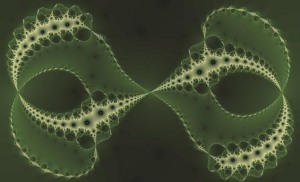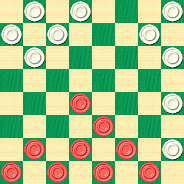The Checker Maven
Jump to navigationInexhaustible

In this age of computerized checkers, with the strongest programs now likely exceeding the capability of even the top human champions; and with the announced intention of the Chinook project to 'solve' the game completely, we often hear that checkers is exhausted, worn out, and no longer of interest.
Well, in this article we're about to disprove that notion--- as if it needed disproving.
Let's look at a position from Richard Pask's excellent book, Key Themes, which, by the way, we'll be offering here in a free, newly typeset electronic edition sometime in this spring (2006). The theme is "The Sunken Piece on Square 5" and we arrive at the diagram below from 11-15 23-19 9-14 22-17 5-9 17-13 14-18! 19-16 12-19 26-23 19-26 30-5.

BLACK
Black to Play and Draw
B:W32,31,29,28,27,25,24,21,13,5:B15,10,8,7,6,4,3,2,1.
Let us first assure you that the position is indeed a draw. Black may be a man down but the White piece on square 5 is very much out of the action. Mr. Pask, in his book, gives a continuation from published play, resulting in a draw. But deep computer analysis shows that there are other possibilites, and the Black draw be obtained in at least a couple of different and very interesting ways.
We invite you to do your own analysis, and see how you think Black might draw. Then click on Read More for a few different takes on the position. We think you'll be completely convinced that, as far as the human mind is concerned, checkers is anything but old and tired, and is a truly limitless art.![]()
Analysis
Amazingly, this position is in the Kingsrow opening book. Kingsrow rates the position as a highly-likely draw and gives the following continuation, ending in a spectacular shot:
15-18 24-20 8-11 21-17 4-8 25-22 18-25 29-22 10-15 27-23 15-18 22-15 11-27 32-23 8-11 31-26 6-10 26-22 11-15 28-24 10-14 17-10 7-14 13-9 3-7 20-16 14-18 23-14 7-10 14-7 2-27 Drawn.
Cake Manchester initially rates the position as having a slight but recognizable advantage for White, but goes on to demonstrate the draw, also ending in a shot:
15-18 25-22 18-25 29-22 10-14 22-17 14-18 27-23 18-27 32-23 8-11 24-19 7-10 28-24 4-8 31-27 8-12 17-14 10-17 21-14 6-9 13-6 1-17 Drawn.
In both examples, White's man on 5 is virtually useless and the rest of his position is somewhat inferior, and eventually he must give back the extra piece and concede the draw.
The continuation from published play was as follows:
8-11---A 25-22---B 4-8 29-25 8-12 27-23 11-16---C to a draw.
A---The Kingsrow opening book prefers 15-18, rated as a highly-likely draw.
B---Kingsrow rates this move at -1, a very likely draw; instead, the program prefers 27-23, rated at -18, or a small advantage to White (100 would be the value of a full man up), and gives this line of play: 27-23 4-8 32-27 15-19 23-16 11-20 24-19 10-14 25-22 7-11 29-25 retaining a very slight edge for White, but still likely to draw. A computer playout gives one possibility as 8-12 19-16 12-19 27-24 20-27 31-8 3-12 22-17 6-10 13-9 14-18 17-13 10-14 28-24 12-16 24-20 16-19 9-6 (White gives back the extra man to free the piece on 5 and concedes the draw) 1-10 5-1 etc. Drawn. Many other variations are surely possible.
C---Kingsrow agrees and rates this position at a value of 1, which is a highly likely draw.
With so much depth in just this one position, can we possibly say that there is nothing of interest left in checkers? Computers may dig deep and come up with "all the answers" some day, but as a game for humans, it is infinite and inexhaustible.
You can email the Webmaster with comments on this article.
